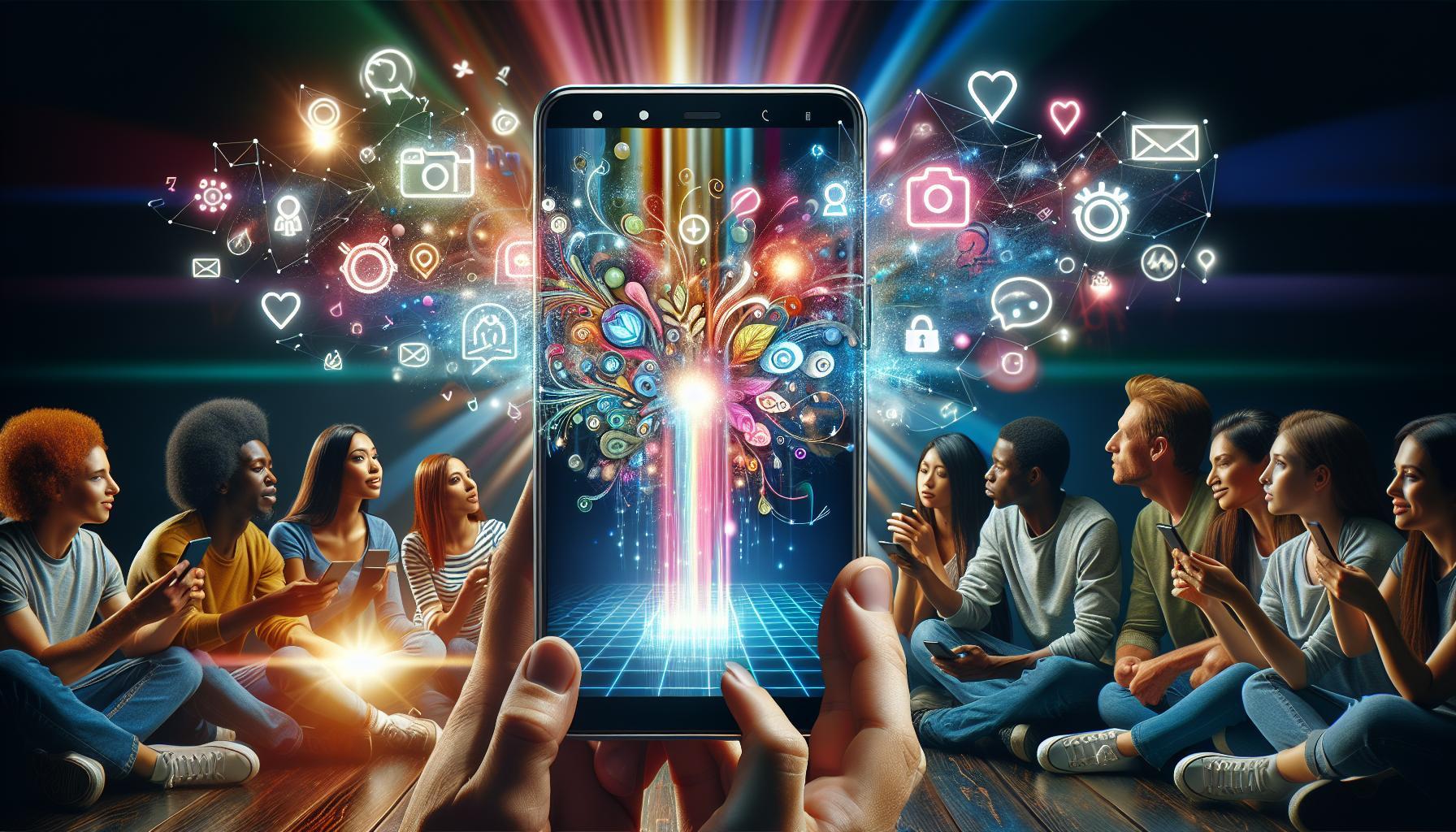In the age of social media, Instagram Stories have transformed the way we share fleeting moments. However, many users wonder: does Instagram let you know if someone screen records their Stories? This question is crucial, as privacy and consent are becoming increasingly important in the digital landscape.
Understanding whether your content could be captured without your knowledge can influence what you share and how you connect with others. If you’re cautious about privacy or simply want to know the ins and outs of Instagram’s features, you’re not alone. Join us as we explore what happens when someone screen records your Story and provide clarity on this often-misunderstood aspect of Instagram’s functionality. Your social media savvy starts here!
Does Instagram Notify When You Screen Record a Story?
While navigating Instagram Stories, you might have wondered about the impact of screen recording on your privacy and the privacy of others. Surprisingly, Instagram does not notify users when their Stories are screen recorded. This means that if you decide to capture a moment from someone’s Story without their knowledge, they will not receive any alert or indication that their content has been recorded.
Understanding this can lead to varied reactions from users. Some appreciate the freedom to save memorable content or create snippets for later viewing or sharing, while others may express concern over the ethical implications of such actions. It’s essential to comprehend that the absence of notifications doesn’t translate to an absence of accountability. Recording someone else’s Story without permission can breach trust and potentially lead to backlash if that content is shared or used inappropriately.
For users who want to take control over how their content is shared, it’s wise to establish clear communication. Encourage followers to ask before they record or share your Stories. This open dialogue not only fosters trust but also respects the creative effort behind each post. Additionally, staying informed about Instagram’s evolving privacy features can help users navigate these waters with more clarity, ensuring a safer and more respectful community experience.
Understanding Instagram Story Privacy Settings
Navigating the realm of Instagram Stories can be both exciting and perplexing, especially when considering privacy settings. One of the most common misunderstandings relates to how Instagram handles user notifications regarding screen recordings. It’s vital for users to know that while Stories are designed to be ephemeral-disappearing after 24 hours-this doesn’t mean that content is free from potential capture. Understanding how Instagram’s privacy settings work is crucial for maintaining control over your digital footprint.
Instagram provides users with a customized way to manage their privacy, especially concerning who can see their Stories. You can adjust your Story settings by navigating to your profile, tapping the three horizontal lines in the top right corner, selecting “Settings”, then “Privacy”, and finally, “Story”. Here, you’ll find options to limit who can view your Stories by creating a close friends list or hiding your Story from specific individuals. However, even with these measures, the risk of someone capturing your Story without your knowledge remains because Instagram does not send notifications for screen recordings.
Furthermore, users can find comfort in the ability to view who has seen their Stories, but this viewership does not extend to recorded content. That means while you can see your viewers, you won’t know if someone captures your moment with a screen record, adding a layer of complexity to the interaction. Thus, proactive communication with your followers becomes essential; encourage them to seek permission before saving any of your content. Respecting each other’s digital space can contribute to a positive community atmosphere where privacy is prioritized.
Ultimately, as you engage with Instagram Stories, remain mindful of the platforms you choose to share your creations on and implement the available privacy settings to protect your content. By staying informed of these features and communicating openly with your audience, you foster a respectful and trusting environment that can help mitigate potential privacy issues. Remember, the essence of social media lies in connection and creativity, but that should never come at the expense of your comfort and security online.
What Happens When You Screen Record a Story?
When a user decides to screen record an Instagram Story, it triggers a series of implications and questions around privacy and notifications. Unlike direct messaging or traditional media sharing, Instagram Stories are crafted to be temporary, disappearing after 24 hours. However, this ephemeral nature doesn’t mean the content is immune to being recorded. The key aspect here is that Instagram does not notify users when someone screens their Story. This is an important point of clarification for anyone concerned about privacy: there are no alerts or notifications sent to the content creator when someone saves their Story via screen recording.
Understanding this fact can lead to a broader discussion about digital privacy in social media platforms. For instance, while you may feel comfortable sharing a personal moment in your Story, the reality is that it could be captured and viewed later without your consent. This discrepancy can create discomfort, particularly for those who share content with a limited audience or whom they consider “close friends.” Thus, a user’s comfort in sharing content may be impacted by the knowledge that their Story could be recorded without warning.
Moreover, while you can see who has viewed your Story, this feature does not extend to screen recordings. If someone records your Story, their view will not appear in your viewer list, amplifying the uncertainty around who might be capturing your moment without permission. This can lead to an awkward atmosphere where users might feel hesitant to share genuine or spontaneous moments, knowing they lack control over how that content might be reused or re-shared.
If you’re looking to share your content with more privacy in mind, consider using available settings to limit who can see your Stories. Utilize features such as Close Friends, allowing you to share personal stories with a select audience rather than broadcasting to all your followers. By doing this, you can create a safer sharing space while maintaining the essence of connection that Instagram fosters.
Screen Recording: Myths and Realities
The notion that screen recording on Instagram might provoke a barrage of notifications is a prevalent myth. In reality, the mechanics of how Instagram operates provide a layer of anonymity for users who decide to capture content via screen recording. Understanding the interplay between user action and platform protocol is essential for anyone navigating Instagram’s ephemeral Stories.
First, it’s vital to clarify that Instagram does not notify users when their Story is recorded. This absence of notification can be both a relief and a concern for content creators. For those who frequently share personal moments, knowing there’s no alert when someone records their Story can foster a sense of freedom in posting; however, it can also lead to feelings of vulnerability. Users may think twice about what they share, especially if they’ve posted content intended for a limited audience.
Alongside the lack of notifications, the privacy settings available on Instagram can often appear misleading. While creators can see who has viewed their Stories, this list does not include anyone who has opted to screen record. This gap in visibility means that users might engage with content that feels more intimate, unaware that this interaction could be lingering beyond its intended ephemeral lifespan. To address this, users can take proactive steps to secure their Stories, like utilizing the Close Friends feature to share content more selectively.
Furthermore, the myth surrounding screen recording isn’t solely about user notification; it extends to the capabilities and limitations of third-party applications. Many users are drawn to these tools, believing they can offer enhanced features and functionalities for capturing screen activity. However, they should approach these with caution, as reliance on external apps can lead to breaches of privacy and unintended sharing of recorded content. By understanding the actual functionality of Instagram and the implications of screen recording, users can navigate the platform more securely, balancing their need for sharing and their desire for privacy effectively.
How to Screen Record Instagram Stories Safely
To navigate the nuances of screen recording on Instagram safely, it’s crucial to blend awareness of the platform’s mechanics with a strategic approach to content sharing. While Instagram does not notify users when someone records their Story, this anonymity comes with responsibilities. Users should always consider the implications of capturing content meant to be transient, ensuring they respect the privacy of others while protecting their own.
Firstly, familiarize yourself with your device’s built-in screen recording feature. Most smartphones come equipped with these functionalities, which can typically be accessed through the control panel. For example, on iOS devices, you can quickly tap the screen recording icon in the Control Center before viewing the Story you wish to capture. This streamlined method emphasizes that you should only record content you’re comfortable being potentially shared outside its original context.
Here are some practical steps to enhance safe screen recording:
- Ask for Permission: Before recording someone else’s Story, it’s a respectful practice to ask for their consent, fostering mutual trust and safeguarding privacy.
- Use the Close Friends Feature: If you’re sharing sensitive content through Stories, leverage Instagram’s “Close Friends” option. Sharing with a select group reduces the risk of unintended sharing or screen recording.
- Review Settings Regularly: Stay updated with Instagram’s privacy settings. Regularly check who can see your content and adjust your settings to maintain control over your audience.
- Understand the Limits of Recording Tools: While third-party apps may offer advanced features, be cautious as they can pose risks to your content’s confidentiality. Stick to your device’s native function when possible.
Ensuring you follow these steps can help maintain a balance between enjoying the fleeting nature of Instagram Stories and respecting the privacy of what can be powerful and intimate moments. By being mindful while recording, you contribute to a culture of respect and consent on social media.
No Notifications: Why Your Recording Goes Unseen
When you hit the screen record button while watching an Instagram Story, you may feel a rush of excitement about capturing fleeting moments. However, it’s crucial to understand that Instagram does not notify users if someone records their Story, allowing for a sense of privacy that is often assumed when sharing content meant to disappear. This lack of notification might lead to a false sense of security for both the person recording and the original poster, complicating the dynamics of trust and respect on the platform.
The absence of notifications creates a range of emotional responses. For some users, the potential of unwarranted sharing or misuse of their content can generate anxiety, as they might feel vulnerable knowing anyone could capture their stories without a trace. On the flip side, content creators and casual users alike might be emboldened by this lack of oversight, leading them to share more candid or controversial content, often without considering the potential consequences. Unfortunately, this can erode the sense of community and joint respect that users typically expect on a platform like Instagram, where personal moments are shared.
To navigate these waters responsibly, it’s essential to maintain a code of ethics regarding screen recording. For instance, if you wish to capture a Story, consider reaching out to the creator for permission, thus fostering trust and ensuring that their boundaries are respected. Moreover, awareness of the implications of screen recording can empower users to think critically about their content–both what they share and how it could be perceived once captured. Being thoughtful in your engagement with Stories-both as a viewer and a creator-can lead to a healthier ecosystem on social media.
In sum, while the reality that screen recordings go unnoticed may seem liberating at times, it is important to approach this feature with caution, empathy, and a commitment to mutual respect. By doing so, users can help preserve the integrity of personal expression on Instagram Stories, enriching the experience for everyone involved.
Exploring Third-Party Apps for Screen Recording
When it comes to capturing Instagram Stories, third-party screen recording apps offer a variety of solutions for those looking to save content that is otherwise ephemeral. However, while these tools can make storing coveted moments easier, understanding how to navigate these options safely and ethically is crucial. Numerous apps are available across platforms, each with unique features, and it’s essential to choose one that meets your needs while maintaining user privacy.
Many popular screen recording applications come equipped with intuitive interfaces and high-definition recording capabilities. For instance, apps like AZ Screen Recorder and DU Recorder are highly regarded among Android users for their ease of use, allowing users to record their screens effortlessly with just a few taps. On iOS, built-in screen recording is already included, but for those seeking advanced editing tools, options like Record It! or Go Record! can complement the native capabilities. To start, simply select your preferred app; for third-party apps, you may need to grant specific permissions such as access to your media and microphone.
It’s essential to consider the ethical implications and user privacy whenever you opt to use these tools. Given that Instagram does not notify users if their Stories are recorded, it becomes even more critical to respect those boundaries voluntarily. Always aim for transparency: if there’s a specific Story you wish to save, consider reaching out to the creator for their consent before recording. This not only maintains trust but ensures that your content consumption aligns with the community ethos.
Before diving into any app, doing a quick check for reviews and user feedback can save you from potential issues down the road. Also, be mindful of app updates, as platforms like Instagram are constantly evolving, which may affect how third-party apps operate or their compatibility with Instagram Stories. Staying informed allows you to maximize your experience while respecting both your own and others’ content rights.
Instagram’s Stance on User Privacy
Considering the evolving norms of digital interaction, Instagram remains firm in its commitment to user privacy. While many users may think about capturing ephemeral content like Stories, it’s crucial to understand that Instagram does not currently notify users when their Stories are screen recorded. This lack of notification allows for a gray area in user behavior, where individuals might record content without the creator’s knowledge, leading to potential privacy concerns.
Instagram’s approach is fundamentally rooted in the idea of user control and transparency in sharing. The platform emphasizes that users should feel free to express themselves without the fear of unauthorized captures of their content. Despite this, the responsibility lies with users to respect the boundaries of privacy. In environments where users share personal or sensitive information, it becomes even more vital to approach screenshotting and screen recording ethically, prioritizing consent and mutual respect.
For content creators, understanding this dynamic is essential. They should actively communicate their preferences regarding privacy and content sharing with their audience. Leveraging features like close friends or private accounts can help control the audience that views more personal Stories, reducing the likelihood of unwanted recording. The key lies in fostering a culture of respect around content consumption, where open dialogue about privacy preferences becomes the norm.
As Instagram continues to innovate, its privacy settings may evolve, reflecting user feedback and community culture. Staying informed about updates not only aids users in protecting their own content but also empowers them to engage responsibly within the platform. By being aware of these privacy principles, users can navigate Instagram in a way that respects both their own and others’ digital footprints, reinforcing a trustworthy social network.
Protecting Your Own Stories from Recording
In the digital age, protecting your content has never been more vital, especially on platforms like Instagram where ephemeral content such as Stories can disappear in a day. One of the major concerns users have is the risk of their Stories being screen recorded without consent. While Instagram currently does not notify users when their Stories are recorded, there are effective ways to safeguard your content from unauthorized captures.
One of the most effective methods to shield your Stories is utilizing the Close Friends feature. By adding select followers to your Close Friends list, you can share more personal content that only they will see. This creates a trust circle where the audience is more likely to respect your privacy. To set this up, tap your profile icon, navigate to the three horizontal lines in the top right corner, select “Close Friends,” and choose who to add. Not only does this limit your audience, but it also fosters a community where your privacy needs are understood.
Another practical approach is to frequently adjust your privacy settings. You can switch your account to private, allowing only approved followers to view your content, including Stories. This simple adjustment can significantly reduce the likelihood of unwanted views. To change your privacy settings, go to your profile, tap “Settings,” then “Privacy,” and toggle on “Private Account.” This gives you greater control over who can access your posts and Stories.
If you’re sharing sensitive or highly personal content, consider using temporary posts or platforms designed for privacy. Instagram offers the option to share Stories that disappear after 24 hours, but you can further enhance your content’s privacy by taking advantage of direct messaging for sharing more private moments. You can decide who sees your message by choosing recipients carefully.
Lastly, engaging your audience through open discussions about privacy is vital. Encourage your followers to respect your content by clearly stating your privacy expectations in your Stories and posts. Use captions or text overlays to communicate your preferences, reinforcing the importance of mutual respect in content sharing.
Implementing these strategies can significantly empower you as a content creator and mitigate the risks involved with potential screen recording. Always remember, while you cannot prevent every instance of recording, fostering a culture of respect and privacy within your community can go a long way in protecting your digital footprint on Instagram.
User Reactions: Privacy Concerns and Screen Recording
Understanding that images and videos can be screen recorded without notification has left many Instagram users concerned about privacy. With the rise of content sharing on social media, there’s an underlying anxiety regarding how easily one’s moments can be captured and potentially misused. Users often resort to various methods to protect their privacy, yet the fear of uninvited captures persists, especially when sharing personal stories or sensitive information. It’s crucial to explore the sentiments surrounding this issue, revealing both user reactions and common misconceptions about privacy on the platform.
Many users express frustration over the absence of notification when someone screenshots or screen records their Stories. The belief that followers respect content creators’ privacy fades, sparking worries about trust within the community. Some users might find solace in Instagram’s features such as the Closest Friends list, which allows content to be shared with a select group, thus mitigating the risk of unwanted exposure. Others, however, feel the need for stronger regulations from Instagram to address privacy concerns adequately. This sentiment is often echoed in discussions across various platforms, where users seek reassurance that their moments remain genuinely ephemeral and not subject to unauthorized capture.
As awareness grows about this feature-or lack thereof-dedicated content creators are learning how to navigate these waters. It’s not uncommon for someone to reflect on past instances where personal stories ended up circulated outside their intended audience. To combat these concerns, many are becoming increasingly vocal about explicitly stating their privacy preferences within posts or utilizing direct messaging for more personal interactions. By discussing these topics openly, they aim to foster an environment of respect and mutual understanding among their followers, reinforcing the idea that consent should be foundational in sharing any content.
Moreover, digital literacy has become paramount amid these revelations, with users encouraged to educate themselves about the nuances of the platform. Misunderstandings about the capabilities within Instagram contribute to anxiety over privacy, thus emphasizing the importance of staying informed. As the platform evolves, users must continuously adapt their strategies, maintaining a proactive stance on privacy while navigating the complexities of digital sharing. Ultimately, the dialogue around screen recording and privacy continues to grow, pushing both individuals and the platform to reconsider how they address content protection moving forward.
Common Troubleshooting Tips for Screen Recording Issues
When trying to capture Instagram Stories through screen recording, users often encounter issues that can hinder their experience. Understanding the common troubleshooting tips can help you navigate these challenges effectively. Here are several actionable steps you can take to ensure a smooth screen recording process.
First, ensure that your device is equipped for screen recording. Most smartphones now include this feature natively, but you need to enable it. For iOS devices, head over to Settings > Control Center, then tap on Customize Controls and add Screen Recording. For Android users, this can usually be found in the Quick Settings panel-just swipe down from the top of the screen to access it. Having the feature readily accessible saves you time and stress during the process.
Next, pay attention to your app updates. Instagram regularly rolls out updates that can affect functionality. To check for updates, visit your device’s app store (Google Play Store for Android, App Store for iOS), search for Instagram, and tap Update if available. Running the latest version ensures you have all the latest features and bug fixes. This proactive approach minimizes the chances of encountering issues related to outdated software.
Another common concern is storage space. A low storage amount on your device can hinder the screen recording process. Make sure to periodically check your storage availability by going to Settings > General > iPhone Storage (iOS) or Settings > Storage (Android). If you’re low on space, consider deleting unnecessary apps or media files, which can help preserve your ability to record.
Finally, if you find that the recorded video has no sound, this could be due to your recording settings. On iOS, when you activate screen recording, be sure to tap and hold the screen recording icon in Control Center, then toggle the microphone audio to On if you wish to capture sound. For Android, settings may vary by manufacturer, so check within the screen recording interface to enable audio capture.
By following these troubleshooting tips, not only can you enhance your Instagram Story recording experience, but you can also feel empowered to capture moments knowing you have the tools and knowledge to address potential hurdles efficiently.
Staying Updated: Changes to Instagram’s Features
Staying informed about changes to Instagram’s features is crucial, particularly regarding privacy and content sharing practices. As users increasingly question how their data and actions are monitored on platforms like Instagram, the platform continues to evolve, reflecting these concerns through incremental updates. For instance, despite widespread speculation, Instagram does not notify users when someone screen records their stories. This decision aligns with the platform’s focus on user engagement, allowing users the freedom to capture shared stories without the social pressure of being surveilled.
Regularly checking for updates is essential to ensure you’re leveraging the latest features Instagram has to offer. Here’s how to stay on top of changes:
- Enable Automatic Updates: For iOS, go to Settings > App Store, then turn on App Updates. On Android, head to Google Play Store settings and enable Auto-update apps.
- Follow Instagram’s Blog: The Instagram blog and official social media accounts often announce new features, policy changes, and tips directly from the platform.
- Engage with Instagram Communities: Forums and subreddits dedicated to Instagram can provide real-time updates and discussions about upcoming trends, enhancing your understanding of platform dynamics.
Furthermore, Instagram frequently rolls out experimental features through the “Instagram Testers” program, offering a sneak peek into future functionalities. Participating in these beta programs allows you to become familiar with new tools before they are fully launched, providing a competitive edge in crafting your social media strategy.
As privacy concerns continue to shape user behavior, staying updated not only enhances your experience but also assists in mitigating potential issues around content capturing and sharing. Adapting to these changes thoughtfully helps maintain the balance between creativity and privacy, ensuring that your engagement on the platform is both enjoyable and secure.
Q&A
Q: Does Instagram inform users if someone screen records their story?
A: No, Instagram does not notify users when someone screen records their story. Although Instagram offers privacy features, screen recording remains an untracked action, allowing individuals to save stories without alerting the original poster.
Q: Can I see who viewed my Instagram story if they screen recorded it?
A: Yes, you can see who viewed your Instagram story, but this information does not indicate whether someone screen recorded it. Instagram only shows the profiles of users who viewed your story but doesn’t track their actions afterward.
Q: What should I do if I suspect someone recorded my Instagram story?
A: While you cannot confirm if someone screen recorded your story, you can adjust your story’s privacy settings. You can restrict visibility to specific users or block accounts if privacy is a concern, which can help protect your content.
Q: Are there any apps that notify users when a story is screen recorded?
A: Currently, Instagram does not support third-party apps that notify users about screen recordings of their stories. Users should remain cautious, as most apps claiming to provide such notifications may not be secure or legitimate.
Q: How can I protect my Instagram stories from being recorded?
A: To protect your Instagram stories, you can adjust your account privacy settings by switching to a private profile. This limits who can view your content and adds an extra layer of control over your stories.
Q: What happens if I use a third-party screen recording app on Instagram?
A: Using third-party screen recording apps can violate Instagram’s terms of service, potentially leading to your account being flagged or suspended. Instagram encourages users to respect privacy and intellectual property rights.
Q: Does Instagram allow saving stories for future viewing?
A: Yes, Instagram allows users to save their stories as highlights on their profile, enabling followers to view them even after they disappear after 24 hours. This feature is beneficial for sharing important moments.
Q: Why do people screen record Instagram stories?
A: Users often screen record Instagram stories to save memorable moments, share content with others, or create compilations. However, this practice raises privacy concerns as it involves capturing someone else’s content without their knowledge.
In Summary
Now that you know Instagram does not notify users when someone screen records a story, you have the freedom to capture those fleeting moments without worry. However, make sure to respect others’ privacy! If you’re interested in maximizing your Instagram experience, check out our guides on “Instagram Privacy Settings” to learn how to protect your own stories and “How to Create Engaging Instagram Stories” for tips to enhance your content.
Don’t miss out-subscribe to our newsletter for the latest tips and updates on social media strategies! Join the conversation and share your thoughts below: have you ever hesitated to record a story? Engage with our community for more insights, and explore our other resources for becoming a pro on Instagram. Your next step to becoming an Insta-expert starts here!




